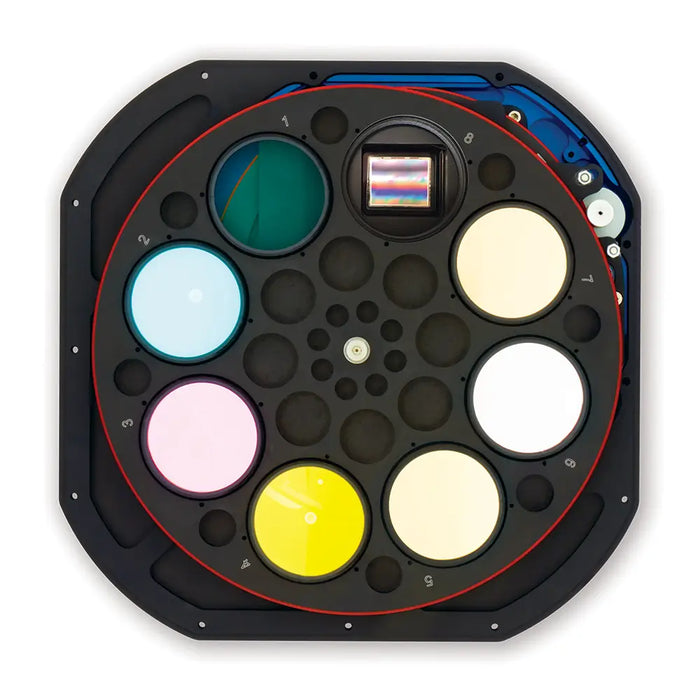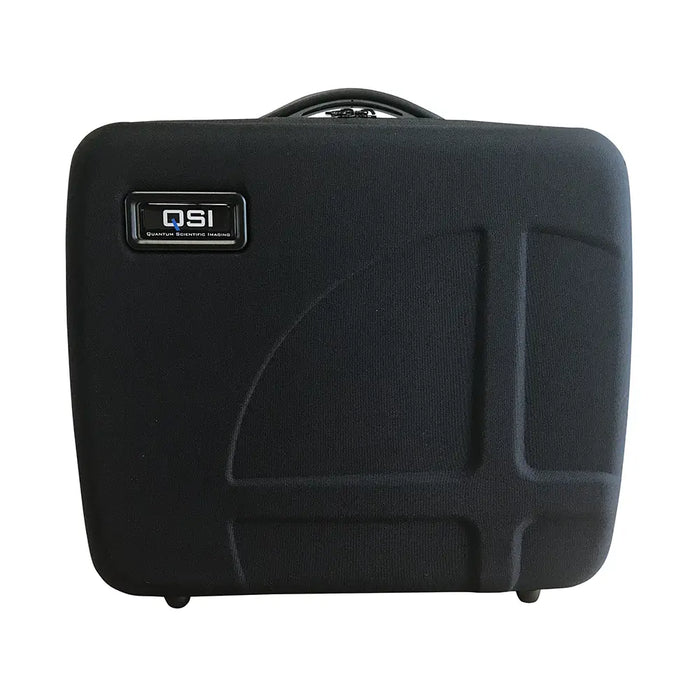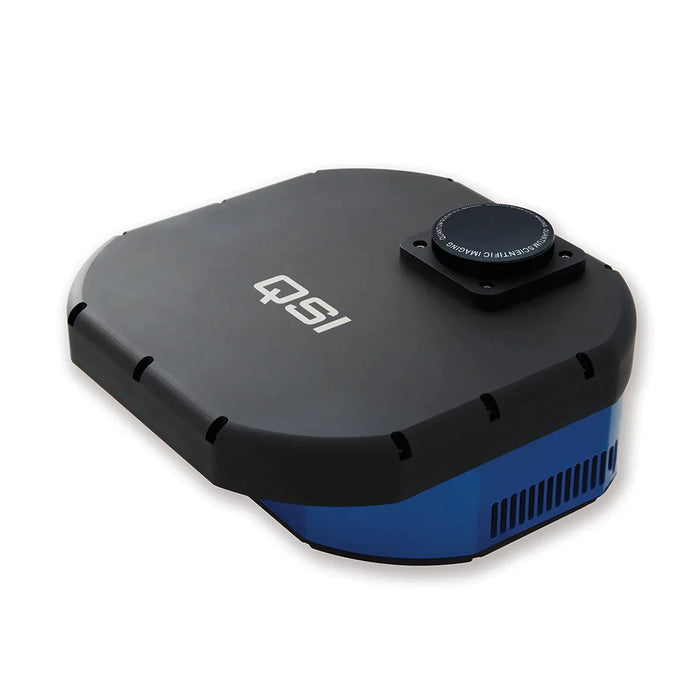QSI 6162
The QSI-6162 model camera model employs a KAF-16200, 16 megapixel, full frame CCD image sensor with microlens technology that has been specifically produced for astrophotography. The 6-micron pixel size make this camera the ideal imaging partner for a wide range of focal length telescopes. The ability to ‘bin’ the CCD means the QSI-6162 is suitable for focal lengths right up to 2.5m and still stay around 1 arc second per pixel (recommended for successful imaging). The large APS-H 16mp CCD sensor with a 35mm diagonal works happily using 2” mounted or 50.8 mm unmounted filters on scopes as fast as f/2.8 with minimal vignetting. The camera is available with or without an Off-Axis Guider and the choice of a five or eight position filter wheel.
The ‘ws’ model comes with a shutter and filter wheel installed. The ‘wsg’ model is supplied with the Off-Axis Guider, Integrated Guider Port (IGP).
The 6162 camera system is supported by industry leading image acquisition software plus a full camera control API is available for creating custom Windows or Linux applications.
Large 16 Megapixel CCD Image Sensor
The 6162-model camera employs an On Semiconductor KAF-16200 16-megapixel full-frame CCD image sensor. The KAF-16200 sensor has a photoactive array of 4490 W x 3599 H pixels. Low dark current of 8e- and a 40,000e- well depth. Micro lenses cover the surface of the CCD to focus the light through the transparent gate to further increase the optical response of the sensor. The 6 µm sized pixels provides extremely high resolution at long focal lengths and superb wide field images at short focal lengths.
The sensor employs a true two-phase charge transfer technology with a transparent gate that significantly increases optical response compared to traditional front illuminated full frame sensors.
The KAF 16200 sensor has excellent response values between 400nm and 1000nm with peak QE over 58%. Low dark current and high pixel charge capacity result in a dynamic range exceeding 69db. Micro lenses cover the surface of the CCD to focus the light through the transparent gate to further increase optical response. See the Specifications tab below for more detail.
High Performance Design
“The QSI 600 Series was designed from the ground up to attain the highest possible imaging performance from Kodak’s Full-Frame and Interline Transfer CCD image sensors.”
Two separate analogue processing chains, providing dual read rates, allow the QSI 600 Series to meet two seemingly incompatible imaging goals. The QSI 600 Series High Quality mode provides the highest possible Signal to Noise Ratio (SNR) for applications that require the lowest noise and widest possible dynamic range. High Speed mode has a read rate of 8MHz providing high speed reads at multiple frames per second. The read mode is easily changed under program control providing exceptional flexibility it tuning the camera’s performance to the desired imaging goals.
All significant performance characteristics, including Linearity, Read Noise, and Photon Transfer (Gain), are tested and confirmed during manufacture. Each camera’s timing and voltages are carefully set during manufacture to ensure maximum Charge Transfer Efficiency, and to minimize charge injection and other secondary noise sources. QSI’s exclusive Research Spec® profiling ensures optimal performance in every camera.
Sophisticated mixed-signal design practices are utilized throughout the camera. This permits a very compact design while eliminating interference from conducted and radiated noise. ROHS compliant multi-layer circuit boards and surface-mount components are used exclusively. A unique circuit board stacking methodology eliminates interconnecting wires that could reduce reliability.
A carefully designed and isolated switching power supply generates all of the voltages needed to operate the camera from a single 12VDC power source. Low noise design practices and advanced filtering techniques completely eliminate any measurable impact on camera noise performance.
Arguably, the most important aspect of a CCD camera design is the video processing subsystem. This is where almost all of the camera’s performance characteristics are established. The 600 Series video processing begins with a very low noise, precision preamp to accurately amplify the microvolt level pixel signal from the CCD image sensor. This signal is then processed through a Correlated Double Sampler (CDS) to reduce temporal read noise in the pixel signal. Subsequent signal conditioning then feeds the pixel level to a high-speed, precision 16-bit Analog to Digital Converter (ADC) where it is converted to a digital value between 0 and 65535.The Read Noise contributed by this entire subsystem is exceedingly small. So small in fact, that it is virtually undetectable, contributing less than 1/30 of the combined read noise of a typical KAF image sensor. The low read noise and carefully chosen camera gain yield excellent Dynamic Range. Linearity is also outstanding, limited only by the CCD image sensor itself.
Innovative, Aesthetic Body Design
The new large format QSI 6162 sets new standards for full-featured, high performance scientific CCD cameras. The striking appearance, refined design and superior fit and finish only hint at the advanced technical performance inside. Some have described it as a work of art.
A defining feature of the 600 series camera is the flexible design that permits progressively configured body styles with a minimal impact on the overall size. The new 6162 case builds on this modular approach by adding an optional Off Axis Guider to the ‘ws’ style case without having to replace the whole case front as in the past. This helps to provides a cheap and easy upgrade path not available before with QSI cameras.
Engineered with extensive use of sophisticated CAD – CAM design tools, the QSI 6162 is machined from 6802 grade aluminium alloy. The finely finished anodized body components are assembled with corrosion resistant stainless-steel hardware throughout.
Keeping the depth of the camera to a minimum was an early design goal. The traditional short back focus measurements of the existing QSI 600 series cameras have been maintained with the design of the 6162. Not only is back focus minimized throughout the range, but the camera moment-arm is reduced resulting in greater stability. The shutter and filter wheel were placed inside the body, very close to the image sensor reducing back focus and overall depth. The motion control electronics are actually buried in the 3 mm thick shutter/filter mounting plate to reduce depth further. Pulling the cooling fans and heatsinks into the body resulted in another significant reduction in depth.
CCD Cooler Subsystem
Key in the design of the 6162 Series cameras is a very efficient custom 2-stage thermoelectric cooler (TEC) subsystem. Intelligent, programmable cooling fans are integrated into the rear of the camera body to remove the heat generated by the cooler. Typically, forced air cooling lowers the regulated CCD temperature by up to 45°C below ambient utilizing 85% power. Tight +/- 0.1°C temperature regulation is maintained at temperature settings of 10°C below ambient and lower.
The cooled CCD image sensor is positioned in a hermetically sealed environmental chamber covered with an anti-reflection coated precision optical window. The chamber is purged with an ultra-dry noble gas to increase heat conduction and eliminate the possibility of frost forming inside the chamber. To extend the useful period before re-purging is required, a user-rechargeable microsieve desiccant is employed to scavenge water molecules that enter the chamber. It is located behind a sub-micron, gas-permeable membrane to prevent particulate contamination of the CCD chamber.
Cooling and Dark Current
Effective cooling of the CCD image sensor is essential for long exposure imaging, especially in astronomy. Thermally generated electrons accumulate in the pixels over time and compete with the photo-electrons that make up the image. This accumulation of thermal electrons is known as ‘dark current’. It lowers the dynamic range of the sensor and reduces the signal to noise ratio. Eventually the thermally generated electrons will swamp the image.
Fortunately, dark current can be reduced dramatically by cooling the CCD. Onsemi CCD sensors accumulate thermal electrons at a rate of roughly 4 electrons per second per pixel at 25°C. With every 6.3°C decrease in temperature the dark current is reduced by half. Where a 10-minute exposure might generate 2400 thermal electrons at 25°C, it will produce only about 10 at -25°C. This is a very small number when compared to the CCD read noise and pixel full well capacity.





